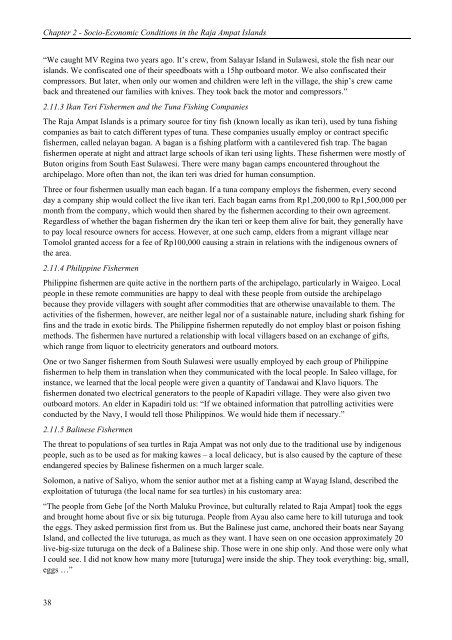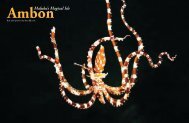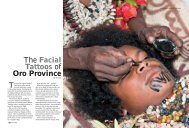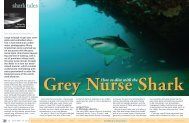Rapid Ecological Assessment - Indo-Pacific Images
Rapid Ecological Assessment - Indo-Pacific Images
Rapid Ecological Assessment - Indo-Pacific Images
- No tags were found...
You also want an ePaper? Increase the reach of your titles
YUMPU automatically turns print PDFs into web optimized ePapers that Google loves.
Chapter 2 - Socio-Economic Conditions in the Raja Ampat Islands<br />
“We caught MV Regina two years ago. It’s crew, from Salayar Island in Sulawesi, stole the fish near our<br />
islands. We confiscated one of their speedboats with a 15hp outboard motor. We also confiscated their<br />
compressors. But later, when only our women and children were left in the village, the ship’s crew came<br />
back and threatened our families with knives. They took back the motor and compressors.”<br />
2.11.3 Ikan Teri Fishermen and the Tuna Fishing Companies<br />
The Raja Ampat Islands is a primary source for tiny fish (known locally as ikan teri), used by tuna fishing<br />
companies as bait to catch different types of tuna. These companies usually employ or contract specific<br />
fishermen, called nelayan bagan. A bagan is a fishing platform with a cantilevered fish trap. The bagan<br />
fishermen operate at night and attract large schools of ikan teri using lights. These fishermen were mostly of<br />
Buton origins from South East Sulawesi. There were many bagan camps encountered throughout the<br />
archipelago. More often than not, the ikan teri was dried for human consumption.<br />
Three or four fishermen usually man each bagan. If a tuna company employs the fishermen, every second<br />
day a company ship would collect the live ikan teri. Each bagan earns from Rp1,200,000 to Rp1,500,000 per<br />
month from the company, which would then shared by the fishermen according to their own agreement.<br />
Regardless of whether the bagan fishermen dry the ikan teri or keep them alive for bait, they generally have<br />
to pay local resource owners for access. However, at one such camp, elders from a migrant village near<br />
Tomolol granted access for a fee of Rp100,000 causing a strain in relations with the indigenous owners of<br />
the area.<br />
2.11.4 Philippine Fishermen<br />
Philippine fishermen are quite active in the northern parts of the archipelago, particularly in Waigeo. Local<br />
people in these remote communities are happy to deal with these people from outside the archipelago<br />
because they provide villagers with sought after commodities that are otherwise unavailable to them. The<br />
activities of the fishermen, however, are neither legal nor of a sustainable nature, including shark fishing for<br />
fins and the trade in exotic birds. The Philippine fishermen reputedly do not employ blast or poison fishing<br />
methods. The fishermen have nurtured a relationship with local villagers based on an exchange of gifts,<br />
which range from liquor to electricity generators and outboard motors.<br />
One or two Sanger fishermen from South Sulawesi were usually employed by each group of Philippine<br />
fishermen to help them in translation when they communicated with the local people. In Saleo village, for<br />
instance, we learned that the local people were given a quantity of Tandawai and Klavo liquors. The<br />
fishermen donated two electrical generators to the people of Kapadiri village. They were also given two<br />
outboard motors. An elder in Kapadiri told us: “If we obtained information that patrolling activities were<br />
conducted by the Navy, I would tell those Philippinos. We would hide them if necessary.”<br />
2.11.5 Balinese Fishermen<br />
The threat to populations of sea turtles in Raja Ampat was not only due to the traditional use by indigenous<br />
people, such as to be used as for making kawes – a local delicacy, but is also caused by the capture of these<br />
endangered species by Balinese fishermen on a much larger scale.<br />
Solomon, a native of Saliyo, whom the senior author met at a fishing camp at Wayag Island, described the<br />
exploitation of tuturuga (the local name for sea turtles) in his customary area:<br />
“The people from Gebe [of the North Maluku Province, but culturally related to Raja Ampat] took the eggs<br />
and brought home about five or six big tuturuga. People from Ayau also came here to kill tuturuga and took<br />
the eggs. They asked permission first from us. But the Balinese just came, anchored their boats near Sayang<br />
Island, and collected the live tuturuga, as much as they want. I have seen on one occasion approximately 20<br />
live-big-size tuturuga on the deck of a Balinese ship. Those were in one ship only. And those were only what<br />
I could see. I did not know how many more [tuturuga] were inside the ship. They took everything: big, small,<br />
eggs …”<br />
38





